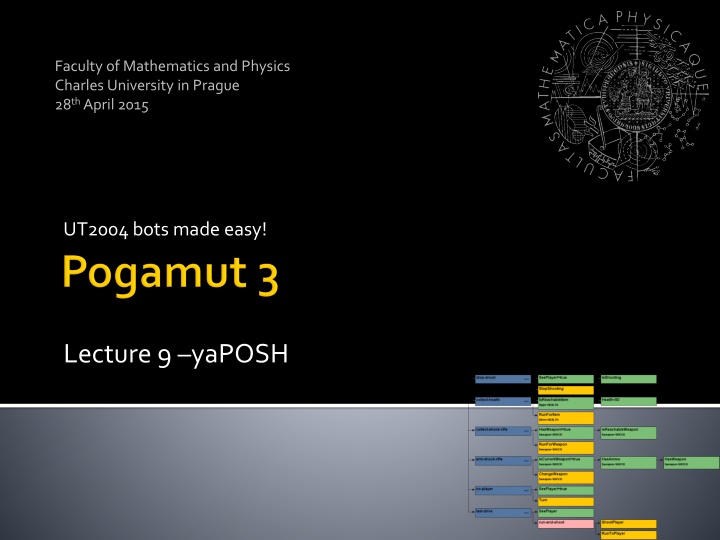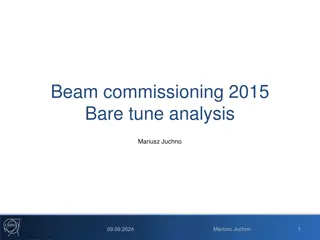
Easy Development of Intelligent Agents Using Behavior-Oriented Design
Discover the methodology of Behavior-Oriented Design for efficient control of intelligent agents in virtual reality environments. Learn how to specify decision-making processes, identify sensors needed, set behavior priorities, and define switching conditions. Enhance your agent's behavior with clear goal-setting and recursive refinement techniques.
Uploaded on | 1 Views
Download Presentation

Please find below an Image/Link to download the presentation.
The content on the website is provided AS IS for your information and personal use only. It may not be sold, licensed, or shared on other websites without obtaining consent from the author. If you encounter any issues during the download, it is possible that the publisher has removed the file from their server.
You are allowed to download the files provided on this website for personal or commercial use, subject to the condition that they are used lawfully. All files are the property of their respective owners.
The content on the website is provided AS IS for your information and personal use only. It may not be sold, licensed, or shared on other websites without obtaining consent from the author.
E N D
Presentation Transcript
Faculty of Mathematics and Physics Charles University in Prague 28th April 2015 UT2004 bots made easy! Lecture 9 yaPOSH
Fill the short test for this lessons 8 minutes limit http://alturl.com/zgu9b https://docs.google.com/forms/d/1MT1- Xi6YBWtFSrtKQJE-7su2O_-h6B0UhuLnGwiO- Hk/viewform
1. Big Picture 2. BOD & POSH 3. yaPOSH 4. Simple DMBot in yaPOSH
1. Big Picture 2. BOD & POSH 3. yaPOSH 4. Simple DMBot in yaPOSH
BOD (Behavior Oriented Design) A methodology for developing control of complex intelligent agents virtual reality characters, humanoid robots or intelligent environments Combines the advantages of Behavior- Based AI and Object Oriented Design. Authored by Joanna J. Bryson http://www.cs.bath.ac.uk/~jjb/web/bod.html
Behavior Oriented Design by Joanna J. Bryson (UK) http://www.cs.bath.ac.uk/~jjb/web/bod.html 1. Specify top-level decision a) Name the behaviors that the bot should do b) Identify the list of sensors that is required to perform the behavior c) Identify the priorities of behaviors d) Identify behavior switching conditions 2. Recursion on respective behaviors until primitive actions reached
State the goal of you agent behavior E.g. It will be a Deathmatch bot Brainstorm what it will mean to fulfill the behavior goal E.g. fight players, gather items Think about conditions that should be fulfilled for the respective behaviors E.g. I ll fight only when I see enemy and have proper weapon Revise, revise, revise Oh wait, what if I don t have the proper weapon, I should add a behavior to flee from fight and gather some weapon. Pick one of the specified top level behaviors and apply recursion from point 1! When you end up with sufficiently simple and clear defined sense/action NAME IT WELL, implement it and test it! 1. 2. 3. 4. 5. 6.
Recursion == Iterative development 1. Select a part of the plan to extend next. 2. Extend the agent with that implementation Extend the plan, code actions and senses Test and debug that code (!!!) 3. Revise the current specification.
Name the behaviors (functions) logically! Good method name is better than documentation! Reduce code redundancy Use copy paste with caution or not at all! Avoid Complex Conditions The shorter condition, the better the understanding Avoid Too Many If-then rules at one level One level of decision making usually needs no more than 5 to 7 if-then rules, they may contain fewer.. When in doubt, favor simplicity.
POSH Parallel-rooted, OrderedSlip-stackHierarchical planner To put it simply: a reactive planner working with FIXED, PRE-SET plans To put it simpler: a tool enabling to specify if then rules with priority in a tree like structure Advantage: Makes you think about the behavior in human terms more than the code There are multiple POSH implementations POSH, pyPOSH, JavaPOSH, yaPOSH, Their language varies a lot
General structure of the POSH tree Root is a Drive Collection Root s children are Drives Drive child is either Competences, or Action Pattern or Action Competence children are again either Competences, or Action Pattern or Action Almost every node has associated a triggering/goal condition [Bryson, 2001]
Action Pattern (a1, a2, , an)a sequence of actions e.g., "baa" and look at it (sheep) Competence: {s1, , sn}a set of competence steps steps that can be performed in different orders (i.e., a set of sequences) one of the steps can be a goal step the competence returns a value: DONE if the goal is accomplished, RUNNING if none of its steps fire Competence step <p, r, a, [n]> a priority, a releaser, an action, a number of retries the action can also be a competence / action pattern [Bryson, 2001]
Drive Collection { d1, , dn }d is a drive element the root of the hierarchy a drive element: <p, r, a, A, [f]> p a priority r a releaser a a currently active element of the drive element (a sub-element) A the top element (i.e., a collection, action pattern, or an action) of the drive element slip-stack f a maximum frequency at which this drive element is visited e.g., jump every five seconds for any cycle of the action selection, only the drive collection itself and at most one other POSH element will have their releasers examined One drive element can suspend temporarily another drive element a competence step cannot interrupt another competence step When the suspending drive element terminates, the suspended drive element continues
Respective DRIVEs and COMPETENCE STEPs has TRIGGERINIG conditions COMPETENCEs has GOAL condition
DRIVEs may have option FREQUENCY decorator COMPETENCEs may have TIMEOUT decorator COMPETENCE STEPs may have RETRY-COUNT decorator
Each DRIVE has an ACTIVE (TOP) ELEMENT that gets executed when DRIVE triggers DRIVE stack (and ACTIVE ELEMENT) is RESET if SWITCHING occurs Multiple DRIVEs can run in parallel (if defined as such)
def init_senses( self ): self.add_sense( "see-player", self.see_player ) ... def init_acts( self ): self.add_act( "move-player", self.move-player ) ... Python def see_player( self ): ... top-level checking period / frequency (RDC life (goal( (fail) ) ) ( drives (( hit( trigger( * (hit-object)(is-rotating False) ) ) avoid )) (( follow( trigger( (see-player) ) ) follow-player )) (( wander( trigger( (succeed) ) ) wander-around )) ) ) terminate (goal) condition timeout condition prio: 1 2 3 "Lisp" (C wander-around (minutes 10) (goal( (see-player) ) ) ( elements (( close-enough( trigger( (close-to-player) ) ) stop-bot )) (( move( trigger( (see-player) ) ) move-player )) ) ) if then
def init_senses( self ): self.add_sense( "see-player", self.see_player ) ... def init_acts( self ): self.add_act( "move-player", self.move-player ) ... def see_player( self ): ... (RDC life (goal( (fail) ) ) ( drives (( hit( trigger( (hit-object)(is-rotating False) ) ) avoid )) (( follow( trigger( (see-player) ) ) follow-player )) (( wander( trigger( (succeed) ) ) wander-around )) ) ) (C wander-around (minutes 10) (goal( (see-player) ) ) ( elements (( close-enough( trigger( (close-to-player) ) ) stop-bot )) (( move( trigger( (see-player) ) ) move-player )) ) )
1. Big Picture 2. BOD & POSH 3. yaPOSH 4. Simple DeathMatch Bot in yaPOSH
yaPOSH yet-another Parallel-rooted, Ordered Slip-stack Hierarchical planner To put it simply: a reactive planner working with FIXED, PRE-SET plans To put it even simpler: a tool enabling to specify if then rules with priority in a tree like structure Advantage: Makes you think about the behavior in human terms more than the code
Actions and Senses if (sense) then (action) Drive Collection (DC) First level of if-then rules Competence(C) Second Nth level of if-then rules Action Patterns (AP) Specifies N actions that will be performed in a sequence
Actions (and all nodes) Are DURATIVE Returns FINISHED, RUNNING, RUNNING_ONCE, FAILED Drives No timeout decorator, No slip-stack, No parallelism Competence No goal node (just another inner-reusable node) Competence Step No retry count decorator
DriveCollection / Competence { 1. if (sense1()) then competence1(); return; 2. if (sense2()) then competence2(); return; 3. if (sense3()) then action-pattern1(); return; 4. if (sense4()) then competence3(); { 1. if (sense5()) then action1(); return; 2. if (sense6()) then competence4(); return; 3. if (sense7()) then action2(); return; 4. if (sense8()) then action-pattern(); return; N. return; } } DriveCollection is the root of if-then tree of rules. Competence is another level of if-then tree of rules.
ActionPattern.run() { while (!action1-finished()) { action1(); } while (!action2-finished()) { action2(); } while (!action3-finished()) { action3(); } } ActionPattern is sequence of action.
ActionPattern.run() { if (this.step == 1) { while (!action1-finished()) { action1(); } this.step = 2; } if (this.step == 2) { while (!action2-finished()) { action2(); } this.step = 3; } if (this.step == 3) { while (!action3-finished()) {action3();} this.step = 1; // reset return ActionResult.FINISHED; } } ActionPattern is tracking the step it executed last and always continues from that one.
ActionPattern.run() { if (this.step == 1) { while (!action1-finished()) { action1(); } if (action1-failed()) { this.step = 1; return ActionResult.FAILED; } this.step = 2; } if (this.step == 2) { while (!action2-finished()) { action2(); } if (action2-failed()) { this.step = 1; return ActionResult.FAILED; } this.step = 3; } if (this.step == 3) { while (!action3-finished()) {action3();} if (action3-failed()) { this.step = 1; return ActionResult.FAILED; } this.reset(); return ActionResult.FINISHED; } } Of course, ActionPattern honors FAILED state, which resets it.
ActionPattern.run() { if (step >= children.size()) { this.reset(); return FINISHED; } Node child = children[step]; switch (child.run()) { case FINISHED: ++step; return this.run(); case RUNNING: return RUNNING; case RUNNING_ONCE: ++step; return RUNNING_ONCE; case FAILED: this.reset(); return FAILED; } } ActionPattern.reset() { step = 0; for (Node child : children) child.reset(); }
Senses Represent condition (Do I see a player?) Return basic types Boolean, Integer, Double, String, Can be queried either as ==, !=, >, <, <= or >= E.g.:
Actions Represent an action in the environment Are expected to return: FINISHED (an action has been finished successfully), RUNNING (an IVA action is still being executed within the environment), FAILED (an action execution has failed). Have three methods init(), running(), done()
yaPOSH runs within logic() method you know from standard Java bot yaPOSH will execute until it finds an action that affect the environment and requires new info From the environment. Bad plan may stall the bot!
1.) DRAG & DROP! 2.) Fill template 3.) Edit generated Java source file
1.) DRAG & DROP! 2.) Fill template 3.) Edit generated Java source file
Are created by drag and dropping from POSH editor from the tabs at the right side of IDE
Every POSH action and sense has Context (this.ctx) that contains all Pogamut modules. Context is an editable class that is a part of your POSH bot sources, e.g. AttackBotContext You may use context to store some variables, e.g. Item you are going for or Player you are going to fight
Competences, action patterns, actions and senses can be parameterized
Enables drag and drop Select action or sense you want to add or change from the editor and drag and drop it at desired place Double clicking POSH graphical element opens editor, right clicking opens element menu Support Go to source , breakpoints and debugging Breakpoints PAUSE the botAND the environment
Run the bot in Debug mode (right click the project, select Debug) In the Debug toolbar, click the green circle button to enable POSH plan debugger A window with Debugger appears:
1. Big Picture 2. BOD & POSH 3. yaPOSH 4. Simple DMBot in yaPOSH
Create (Simple) DeathMatchBot in yaPOSH That arms himself and is able to fight an opponent Does not stuck (for long). Points: 5
Access Pogamut modules from POSH actions and senses! this.ctx.getItems().getSpawnedItems(UT2004ItemType.C ategory.WEAPON) MyCollections.getFiltered(Collection, new IFilter<Item>() { }) Handling unreachable items: this.ctx.getNavigation().addStrongNavigationListener ( STUCK_EVENT ) myTabooSet.add() & myTabooSet.filter( ) Specifying weapon preferences: this.ctx.getWeaponPrefs().addGeneralPref(UT2004ItemType.FL AK_CANNON,true) .addGeneralPref(UT2004ItemType.ROCKET_LAUNCHER,true);
Via e-mail: Subject Pogamut homework 2015 Assignment X Replace X with the assignment number and the subject has to be without quotes of course or face -2 score penalization To jakub.gemrot@gmail.com Jakub Gemrot (Tuesday practice lessons) Attachment Completely zip-up your project(s) folder except target directory and IDE specific files (or face -2 score penalization) Body Please send us information about how much time it took you to finish the assignment + any comments regarding your implementation struggle Information won t be abused/made public In fact it helps to make the practice lessons better Don t forget to mention your full name!
We do not own the patent of perfection (yet) In case of doubts about the assignment, tournament or hard problems, bugs don t hesitate to contact us! Jakub Gemrot (Tuesday practice lessons) jakub.gemrot@gmail.com
















